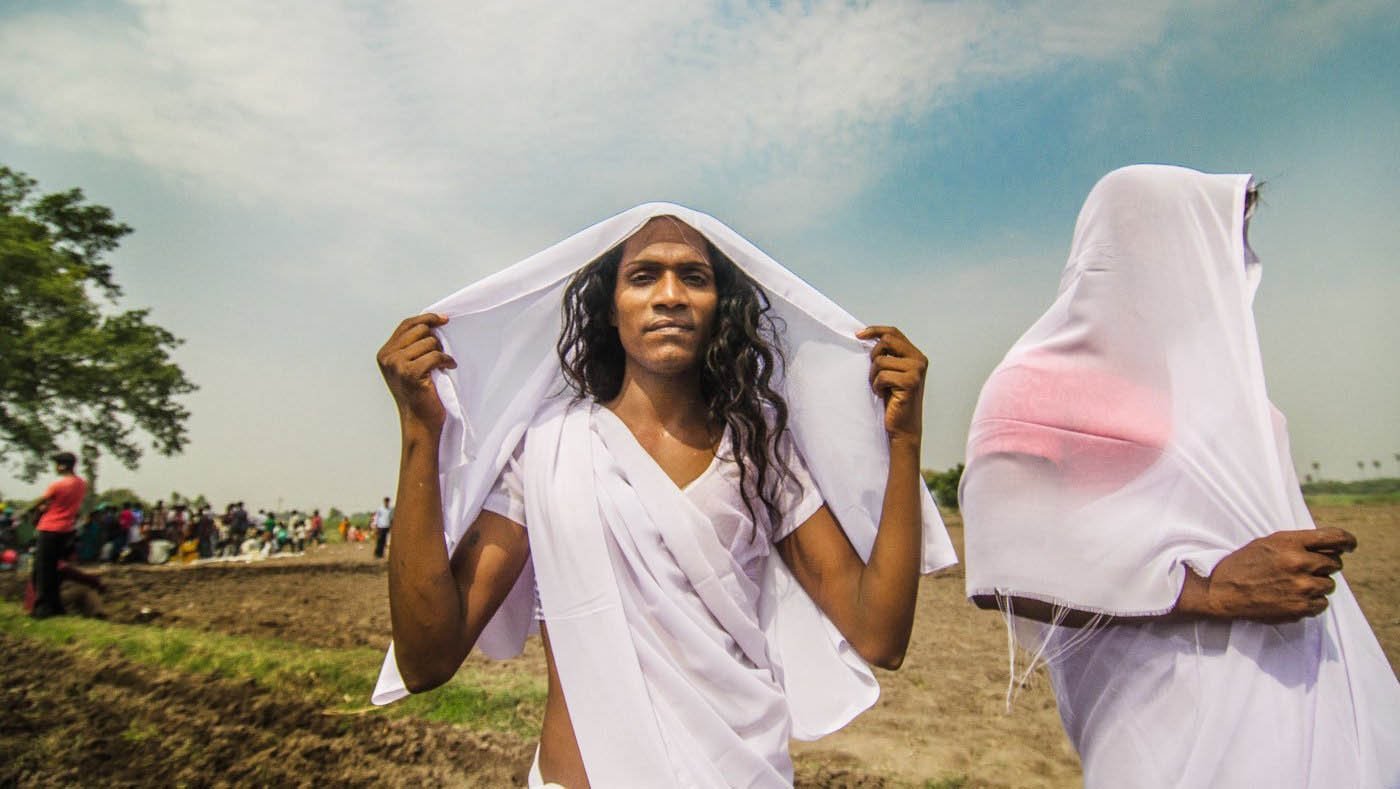ତାମିଲନାଡ଼ୁର କିନ୍ନର ସମୁଦାୟର ସଦସ୍ୟମାନେ ଯେଉଁମାନେ କି ମୋ ସହ ଉଦାର ଭାବରେ କିଛି ସମୟ କଟାଇଥିଲେ ସେମାନେ ନିଜକୁ ‘ ଆରାବାନୀ ’ ଭାବରେ ବର୍ଣ୍ଣନା କରିଥିଲେ। ଅନେକ ବିଳମ୍ବରେ ମୁଁ ଜାଣିଲି ସେମାନଙ୍କ ସମୁହର ଅନେକେ ବର୍ତ୍ତମାନ ଏହି ଶବ୍ଦକୁ ତ୍ୟାଗ କରି ନିଜକୁ ଥିରୁନାଙ୍ଗାଇ ଭାବରେ ପରିଚୟ ଦେଉଛନ୍ତି। ତଥାପି ମୁଁ ଯେଉଁମାନଙ୍କ ସହ କଥା ହୋଇଥିଲି ସେମାନେ ନିଜକୁ ଯେପରି ଭାବରେ ପରିଚିତ କରାଇବାକୁ ଚାହିଁଥିଲେ ତାହା ସମ୍ମାନର ସହ ବ୍ୟବହାର କରିଛି।
‘‘ ଏହା ଆମର ପର୍ବ । ୧୦ଦିନ ପର୍ଯ୍ୟନ୍ତ ଆମେ ଏକ ଭିନ୍ନ ଜୀବନ ଜୀଇଁଛୁ । ଗତ କେଇଦିନ ହେବ ମୁଁ ଏକ ସମ୍ମୋହନ ମଧ୍ୟରେ ଅଛି, ଏବଂ ଏଥିରୁ ବାହାରିବାକୁ ଚାହୁଁନି।’’ ଏକଥା କହିଥିଲେ ବିଲୁପୁରମ୍ ଜିଲ୍ଲାର କୁଭାଗାମ୍ ଗ୍ରାମର ୨୬ ବର୍ଷ ବୟସ୍କା ଆରାବାନୀ ଜୟମାଲା। ମୁଁ ତାଙ୍କୁ ପୂର୍ବେ ୨୦୧୪ରେ ଭେଟିଥିଲି। ସେ ତାମିଲ କ୍ୟାଲେଣ୍ଡର୍ର ଚିତିରାଇ ମାସ(ପ୍ରାୟ ଏପ୍ରିଲ୍ ମଝିରୁ ମେ’ ମଝି)ରେ ଅନୁଷ୍ଠିତ ହେଉଥିବା ବାର୍ଷିକ ଉତ୍ସବରେ ଯୋଗ ଦେବାକୁ ଆସିଥିଲେ। ଏହି ପର୍ବ ପ୍ରାୟ ୧୮ ଦିନ ଧରି ଚାଲେ।
ସାରା ଦେଶରୁ ଅନେକ କିନ୍ନର ସୌନ୍ଦର୍ଯ୍ୟ ପ୍ରତିଯୋଗିତା, ନାଚ ଗୀତ ପ୍ରତିଯୋଗିତା ଏବଂ ଅନ୍ୟାନ୍ୟ କାର୍ଯ୍ୟକ୍ରମରେ ଯୋଗ ଦେବା ପାଇଁ କୁଭାଗମକୁ ଆସନ୍ତି। ଅନେକେ ଆସନ୍ତି ଭଗବାନ ଆରାବନ୍ଙ୍କ ସହ ବିବାହ ପାଇଁ। ମହାଭାରତର ଏକ କଥାରେ ହୋଇଥିବା ବର୍ଣ୍ଣନା ଅନୁଯାୟୀ ବିବାହ ହୁଏ। କୁଥଣ୍ଡବର୍ (ସ୍ଥାନୀୟରେ ଆରାବାନ୍ ଭାବରେ ଜଣାଶୁଣା )ଙ୍କ ପାଇଁ ସମର୍ପିତ ମନ୍ଦିରରେ ଏହି ବିବାହ ଅନୁଷ୍ଠିତ ହୁଏ।
କିମ୍ବଦନ୍ତୀଟି ଏହିପରି : ଅର୍ଜୁନ ଏବଂ ନାଗା ରାଜକୁମାରୀ ଉଲୁପିଙ୍କ ପୁତ୍ର ଆରାବନ୍ କୌରବମାନଙ୍କ ସହ ଯୁଦ୍ଧରେ ପାଣ୍ଡବମାନଙ୍କ ବିଜୟ ପାଇଁ ଦେବୀ କାଳୀଙ୍କ ପାଖରେ ଆତ୍ମବଳୀ ଦେବାକୁ ରାଜି ହୋଇଥିଲେ। ତେବେ ମୃତ୍ୟୁ ପୂର୍ବରୁ ବିବାହ କରିବା ପାଇଁ ତାଙ୍କର ଇଚ୍ଛା ଥିଲା। କିନ୍ତୁ କେହି ତାଙ୍କୁ ବିବାହ କରିବାକୁ ଚାହୁଁ ନଥିଲେ କାରଣ ପରଦିନ ସକାଳେ ତାଙ୍କୁ ବଳୀ ଦିଆଯିବାର ଥିଲା। ତେଣୁ କୃଷ୍ଣ ମୋହିନି ଭାବରେ ନାରୀ ରୂପ ଗ୍ରହଣ କଲେ, ଆରାବନ୍ଙ୍କୁ ବିବାହ କଲେ- କେବଳ ପରଦିନ ସକାଳେ ବିଧବା ହେବାପାଇଁ।
କୁଭାଗମ୍ ଉତ୍ସବରେ ଆରାବନୀମାନେ ଏହି ବିବାହ, ବଳୀ ଏବଂ ବୈଧବ୍ୟର ରୀତି ଦୋହରାନ୍ତି। ମୁଁ ଯେତେବେଳେ ପହଞ୍ଚିଲି ସେତେବେଳେ ବିବାହ ଉତ୍ସବ ଚାଲିଥାଏ। ମନ୍ଦିର ଭିତରେ ପୂଜକ ଜଣକ ପରେ ଜଣେ ଆରାବନୀଙ୍କର ବିବାହ ରୀତି ସମ୍ପନ୍ନ କରୁଥାନ୍ତି। ବାହାରେ ଆରାବନୀମାନେ ନୃତ୍ୟ କରୁଥା’ନ୍ତି ଏବଂ ଫୁଲମାଳ, ଥାଳି, ଚୁଡ଼ି ଆଦି କିଣୁଥା’ନ୍ତି।
ମୁଁ ବେଙ୍ଗାଲୁରୁରୁ ଆସିଥିବା ଆରାବନୀମାନଙ୍କର ଗୋଟିଏ ଗୋଷ୍ଠିକୁ ଭେଟିଲି; ଏହି ଦଳର ନେତ୍ରୀ ପ୍ରଜ୍ୱଲା ମତେ କହିଲେ,‘‘ ମୁଁ ୧୨ ବର୍ଷ ହେବ ଏଠାକୁ ଆସୁଛି। ଏହି ସମାଜରେ ବଞ୍ଚିବା ଆମ ପାଇଁ କଷ୍ଟକର। କିନ୍ତୁ ଏହି ସ୍ଥାନ ମୋତେ ବିଶ୍ୱାସ ଦିଏ ଯେ ଦିନେ ଆମକୁ ଗ୍ରହଣ କରାଯିବ। ଜଣେ ଦେବତାଙ୍କର ପତ୍ନୀ ହେବା ଆମ ପାଇଁ ଏକ ସ୍ୱୀକୃତି।’’
ଯଦିଓ ଏହି ଉତ୍ସବ ଏକ ଆନନ୍ଦର ସମୟ, ଏହାର ଏକ ଅନ୍ଧାରୀ ଦିଗ ମଧ୍ୟ ଅଛି। ଆରାବନୀମାନେ ଗହଳି ଭିତରେ ପୁରୁଷମାନଙ୍କ ଦ୍ୱାରା ଯୌନ ନିର୍ଯ୍ୟାତନାର ଶୀକାର ହେଉଥିବା ଏବଂ ପୋଲିସ୍ମାନଙ୍କ ଅଶ୍ଳୀଳ ଭାଷାର ଶୀକାର ହେଉଥିବା ପ୍ରକାଶ କରିଥିଲେ। ତେବେ ୩୭ ବର୍ଷ ବୟସ୍କା ଆରାବନୀ ଇଭି କହିଥିଲେ, ‘‘ତଥାପି ମୁଁ ଏଠାକୁ ଆସେ ଏବଂ ଏହା ହିଁ କରୁଥିବି।’’ ସେ ଭିଡ଼ ଭିତରେ ହଜିଗଲେ। ମୁଁ ତାଙ୍କୁ ପଚାରିବାକୁ ଚାହୁଁଥିଲି କ’ଣ ତାଙ୍କୁ ପ୍ରତିବର୍ଷ ଏଠାକୁ ଡାକିଆଣେ । କିନ୍ତୁ ଉତ୍ତର ବି ସ୍ଥିର: ଏହା ସେମାନଙ୍କର ଉତ୍ସବ। ଏହା ହିଁ ସେହି ସ୍ଥାନ ଯେଉଁଠାକୁ ସେମାନଙ୍କୁ ସ୍ୱାଗତ କରାଯାଏ ସେମାନେ ଯାହା ସେଥିପାଇଁ।

ଭଗବାନ ଆରାବନ୍ଙ୍କୁ ସମର୍ପିତ ମନ୍ଦିର ( ସ୍ଥାନୀୟରେ କୁଥଣ୍ଡବାର ଭାବରେ ଜଣାଶୁଣା ) କୁଭାଗମ୍ ଗ୍ରାମରେ ଅଛି। ତାମିଲନାଡ଼ୁର ବିଲୁପୁରମ୍ ସହର ଠାରୁ ଏହା ପ୍ରାୟ ୩୦ କିଲୋମିଟର ଦୂରରେ।

ଆରାବନୀମାନେ ମହାଭାରତର ଏକ କାହାଣୀର ଅଭିନୟ କରନ୍ତି ଯେଉଁଥିରେ ସେମାନେ ଭଗବାନ୍ ଆରାବନ୍ଙ୍କୁ ବିବାହ କରନ୍ତି। ଏଠାରେ ସେମାନେ ବିବାହ ପାଇଁ ପ୍ରସ୍ତୁତ ହେଉଛନ୍ତି।

କୁଥଣ୍ଡବାର ମନ୍ଦିରର ଜଣେ ପୂଜାରୀ ବିବାହ ରୀତି ଆରମ୍ଭ କରୁଛନ୍ତି। ସେ ଥାଲି ନାମକ ଏକ ହଳଦିଆ ସୂତା ପ୍ରତ୍ୟେକ ଆରାବନୀଙ୍କ ବେକରେ ବାନ୍ଧି ଦିଅନ୍ତି ଯାହା ଆରାବନଙ୍କ ସହ ତାଙ୍କର ସଂଯୁକ୍ତତାକୁ ସୂଚିତ କରେ।

ନିଜ ଇଷ୍ଟକୁ ବିବାହ କରି ପରିତୃପ୍ତିର ସହ ଜଣେ ବୟସ୍କା ଆରାବନୀ ମନ୍ଦିରରୁ ଫେରୁଛନ୍ତି।

କିନ୍ନର ମହିଳାମାନେ ସାମାଜିକ ବାସନ୍ଦକୁ ସାମ୍ନା କରୁଥିବା ସତ୍ତ୍ୱେ ଲୋକମାନେ ସେମାନଙ୍କୁ ‘ ଶୁଭ ’ ମାନନ୍ତି। ସେମାନେ କୁଥଣ୍ଡବାର ମନ୍ଦିର ବାହାରେ ଆରାବନୀଙ୍କଠାରୁ ଆଶୀର୍ବାଦକୁ ଅପେକ୍ଷା କରି ଜମା ହୋଇ ରୁହନ୍ତି।

ଚେନ୍ନାଇର ସହର ତଳୀରୁ ଆସିଥିବା ନବ ବିବାହିତା ଆରାବନୀମାନଙ୍କ ଦଳର ନେତ୍ରୀ ପିଙ୍କି ( ମଝି ) ବିବାହକୁ ଉତ୍କଣ୍ଠାର ସହ ଅପେକ୍ଷା କରିଛନ୍ତି।

ସେମାନଙ୍କର ବିବାହ ସମ୍ପନ୍ନ ହେବାପରେ ଆରାବନୀମାନେ ଖୁସି ମନାନ୍ତି। ପିଙ୍କି ( ଡାହାଣ ) ଖୁବ୍ ଖୁସିରେ ନିଜ ପ୍ରିୟ ବାନ୍ଧବୀ ତଥା ସହ - ବଧୂ ମାଳାଙ୍କୁ ଚୁମ୍ବନ ଦେଉଛନ୍ତି।

ବିବାହ ରୀତି ଶେଷ ହୋଇଯାଇଛି । ବର୍ତ୍ତମାନ ଏହା କିଛି ମଉଜ ମସ୍ତିର ସମୟ। ଆରାବନୀ ବଧୂମାନେ ସେମାନଙ୍କ ବିବାହ ପୋଷାକରେ ଗୀତ ଗାଆନ୍ତି , ସାରା ରାତି ଖୁସି ମନା ହେଉଥାଏ।

ପରଦିନ ସକାଳ, ଉତ୍ସବର ଶେଷ ଦିନ, ଏହା ଆରାବନଙ୍କ ବଳି ରୀତିର ସମୟ ଏବଂ ଆରାବନୀମାନେ ଶୋକ ମନାଇବା ଆରମ୍ଭ କରନ୍ତି -ସେମାନେ ଏକାଠି ଜମା ହୁଅନ୍ତି, ଗୋଲାକାରରେ ଛିଡ଼ା ହୁଅନ୍ତି ଏବଂ ଉଚ୍ଚ ସ୍ୱରରେ କାନ୍ଦନ୍ତି।

ଜଣେ ପୂଜାରୀ ଜଣେ ଆରାବନୀଙ୍କ ଚୁଡ଼ି ଭାଙ୍ଗନ୍ତି- ବୈଧବ ରୀତି ମଧ୍ୟରୁ ଏହା ଗୋଟିଏ । ଖୁବ୍ ଦୁଃଖରେ ଭାଙ୍ଗିପଡ଼ି ସେ କାନ୍ଦିବା ଆରମ୍ଭ କରନ୍ତି। ପର୍ଯ୍ୟଟକମାନେ ଏହା ଦେଖିବା ପାଇଁ ଛିଡା ହୋଇରୁହନ୍ତି।

ଜଣେ ପୂଜକ ଆରାବନୀମାନଙ୍କ ଥାଲି କାଟି ସେଗୁଡ଼ିକୁ ମନ୍ଦିର ବାହାରେ ନିଆଁରେ ପକାଉଛନ୍ତି।

ବର୍ତ୍ତମାନ ଆରାବନୀମାନଙ୍କୁ ନିଜର ବିବାହ ପୋଷାକ ପରିତ୍ୟାଗ କରିବାକୁ ଏବଂ ଜଣେ ବିଧବା ପରି ଧଳା ପିନ୍ଧିବାକୁ ହେବ। ଏଠାରେ ଜଣେ ଆରାବନୀ ପୂଜକ ତାଙ୍କୁ ଧଳା ଶାଢ଼ି ଦେବା ପରେ କାନ୍ଦିବା ଆରମ୍ଭ କରିଛନ୍ତି।

ଆରାବନୀମାନେ ଆରାବନ୍ଙ୍କ ବଳୀର ଯନ୍ତ୍ରଣା ପ୍ରଦର୍ଶନ ପାଇଁ ସେମାନଙ୍କ ଛାତି ଓ ମୁଣ୍ଡ ବାଡ଼ାନ୍ତି।

ମନ୍ଦିର ନିକଟରେ ବିବାହର ପ୍ରତୀକ ଭାବରେ ବ୍ୟବହୃତ ହେଉଥିବା ସାମଗ୍ରୀର ବଳକା ଜିନିଷ - ବିଛାଡ଼ି ହୋଇ ପଡ଼ିଥିବା ଫୁଲମାଳ , ଭଙ୍ଗା ଚୁଡ଼ି , ଏବଂ କଟା ଥାଲିଗୁଡ଼ିକ

ଧଳା ଶାଢ଼ି ପିନ୍ଧଥିବା ଜଣେ ଆରାବନୀ ମନ୍ଦିରରୁ ବାହାରି ଚାଲିଯାଉଛନ୍ତି ; କେତେକ ଆରାବନଙ୍କ ମୃତ୍ୟୁର ଶୋକ ମାସେ ପର୍ଯ୍ୟନ୍ତ ମନାନ୍ତି।
ଏହି ଫଟୋ ପ୍ରବନ୍ଧର ଏକ ଆଦ୍ୟ ସଂସ୍କରଣ ଫଟୋଗ୍ରାଫର୍ଙ୍କ ୱେବ୍ସାଇଟ୍ରେ ପ୍ରକାଶିତ ହୋଇଥିଲା।
ଓଡ଼ିଶାଲାଇଭ୍




